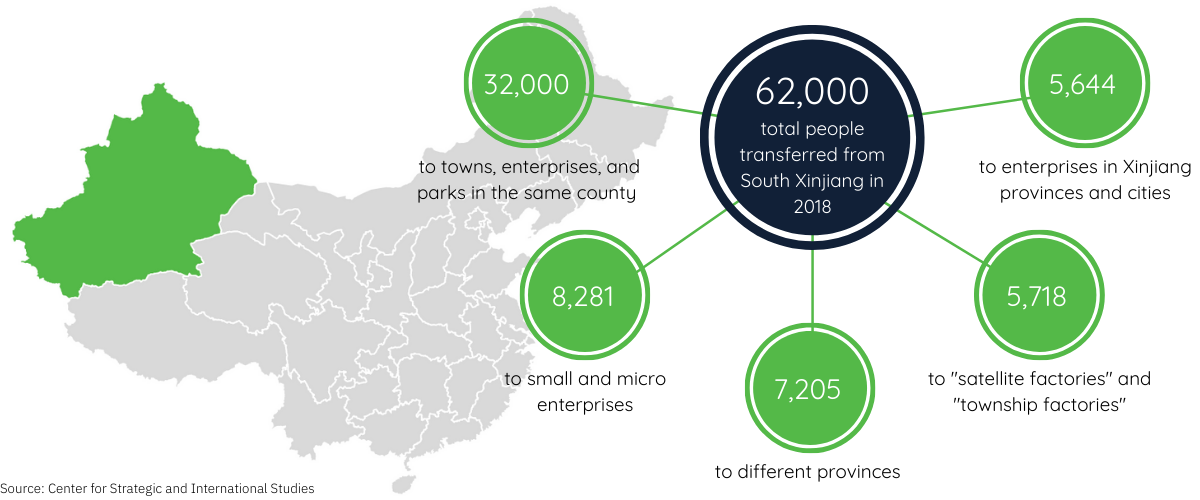A Guide To The Uyghur Forced Labor Prevention Act
In the past few years, the issue of forced labor has gained more attention and awareness as to its prevalence in certain regions around the world. The most recent incident is the Xinjiang Uyghur Autonomous Region (XUAR) in China.
In July 2020, the US government issued a Xinjiang Supply Chain Business Advisory. This advisory highlighted the risks of outbound and inbound exposure to entities engaging with or indirectly supporting forced labor and human rights abuses in Xinjiang.
On September 22, 2020, the House unanimously passed the Uyghur Forced Labor Prevention Act, merely a week after the Department of Homeland Security had blocked imports from four specific entities located in the region. The barred goods produced and/or processed by these entities include cotton, apparel, and hair products. Just a little over a year later on December 23, 2021, President Biden passed the act.
So how is the Uyghur Forced Labor Prevention Act different from other laws targeting modern-day slavery and human trafficking? What new challenges will businesses face and how will they ensure compliance? Let’s dive in.
Understanding The Act
Geopolitical Context
Before we go into the legal meaning of the Uyghur Forced Labor Prevention Act, we’ll quickly map the geopolitical environment of XUAR.
Annexed in 1949, the region is mainly composed of Muslim Uyghur, Kazakh, and Turkic minorities that the Chinese government is determined to “reform.” After Uyghur militants claimed responsibility for attacks in 2013 and 2014, the People's Republic of China has considered the Uyghurs a threat to security and has proceeded to a vast operation of repression and detention, extending to other Muslim minorities as well.
According to an article published in The Guardian, researchers have mapped more than 380 so-called Vocational Education and Training Centers. These detention camps are associated with forced labor, torture, abuse, among other appalling crimes.

Language Of The Act
The Uyghur Forced Labor Prevention Act prohibits the importation of “goods, wares, articles, and merchandise mined, produced, or manufactured wholly or in part” using forced labor under rebuttable presumption.
In short, all goods from XUAR are considered tainted and denied entry on US soil unless companies can prove beyond doubt that they are not, and Customs and Border Protection is able to determine that they weren’t “manufactured by convict labor, forced labor, or indentured labor under penal sanctions.”
High-Risk Sectors
From an economic and industrial standpoint, Xinjiang is a precious region for China and, by extension, the world. It is rich in oil and mineral resources with the highest reserves of beryllium and mica, as well as deposits of coal, iron, nickel, and tungsten. Industries of note include iron, steelworks, and cement factories.
XUAR is also one of the main sources of cotton (80% of the national production). Beyond producing and supplying cotton on a global scale, China manufactures textiles and apparel with unparalleled production capacity and has established itself as the source of choice for variety, volume, and low costs. For perspective, in 2018 the US imported $42.5 billion worth of textile and clothing from China.
Finally, China is deploying vast efforts to further develop the exploitation and infrastructure of this “special economic zone”, which has become a key element of the Belt and Road Initiative.
Needless to say, many supply chains fall under scope of the act.
Complying With The Uyghur Forced Labor Prevention Act
Modern-day slavery is a deeply disturbing reality that is crucial for organizations to address. Under the Act, companies or government programs doing business or associated with Xinjiang will be subject to the presumption of guilt.
Public companies are required to file periodic reports disclosing any engagement with facilities/activities responsible for or complicit with, forced labor, human rights abuse, mass surveillance, and other atrocities.
Non-compliance will result in the seizure of the goods and potential civil and criminal penalties against the importer.
Short of equipping every piece of material, cotton bale, and goods with a tracking device, the only option to eliminate forced labor and human trafficking from the supply chain is to acquire transparency. To reach transparency and visibility, businesses need data. Relying on suppliers’ honesty and a handshake is not wise, whether doing business with the XUAR, somewhere else in China, or anywhere in the world.
Source Intelligence’s Solution
For years, Source Intelligence has successfully helped over 300,000 businesses with their compliance requirements and due diligence efforts. We know that organizations with strong ESG ethics set themselves up for long term success.
Our Uyghur Forced Labor Prevention Act program is based on the lessons learned from years of running our award-winning Conflict Minerals Compliance Program for the world's biggest brands. Our program combines an extensive due diligence process with high-frequency comprehensive searches of your supply chain utilizing supplier location, names, aliases, and other data to deliver compliance.
Our platform offers the full power of AI technology, collecting massive volumes of supplier and geographic data, which we store and aggregate to identify red flags. Our dynamic and collaborative risk-mapping approach offers insights into your entire supply chain so you can proudly state your business is free of forced labor (including via our anti-human trafficking program).
To further sharpen the competitive edge, our supply chain media monitoring program ties into all of our solutions, providing you with even more data points and market surveillance.
Let us give you a tour. After all, a demo is worth a thousand words.



